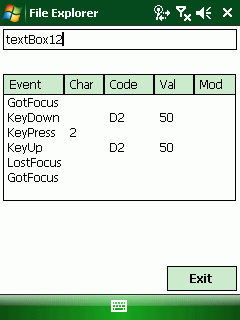Archive for the ‘Keyboard’ Category.
July 16, 2010, 06:02
KeyToggle
Extend your keyboard to get function keys by pressing numbers.
With keytoggle you can define a ‘sticky’ key that will change the beahviour of the number keys. As long as the sticky key is ‘active’, number keys from 1 to 0 will produce the function keys F1 to F10. If sticky key is active, the left LED will light in green.
To start keytoggle just tap it or let it start by a link in StartUp. If keytoggle is loaded, you can see a small yellow arrow sign in the taskbar.

If you tap this symbol, you are asked, if you want to unload the app. If the registry does not have values defined for keytoggle, it will use default values. If you try to launch keytoggle a second time you will get a message box. Only one instance of keytoggle can run at a time.
Using the registry you can define the behaviour of the sticky key. In example, you can have the sticky key remain active until it is pressed again, let it ‘go off’ or ‘fallback’ after a period of time or let it fallback after a number key has been pressed. If the sticky key is pressed again, it will always fallback.
Continue reading ‘Mobile Development: Hooking the keyboard – KeyToggle’ »
March 18, 2010, 17:43
Here is my approach to make a compact framework form fullscreen:
A class that enables you to
- lock/unlock the taskbar
- hide/show the taskbar and resize form to occupy the whole screen
- hide the menu bar but show/hide SIP
- disables OS to capture Function keys like F6/F7 for Volume Up/Down etc and makes these keys available to be used in your app. Also the use of the WinKey does not open the Start Menu

(You are right, you dont see ‘fullscreen’ in the screen shot, BUT the taskbar is locked!)
Continue reading ‘Full Screen Engine to make Compact Framework applications fullscreen’ »
February 10, 2010, 00:24
Hello
Updated on 10. feb 2010
I finished a toolset to free the function keys on windows mobile devices. That means a tool set that will give you back the function keys. Instead of F3 launching the phone app, you can free the F3 key and use it in your app.
Continue reading ‘Use FuncKey to free up your FunctionKeys on Windows Mobile’ »
January 21, 2010, 18:44
Remote Desktop Mobile autologin
As you may know, Remote Desktop Mobile (RDM) does not support auto-login. But sometimes you may want a user does not change settings and is directly connected to a Terminal Server. Ruggedized devices are often used in warehouses and the IT structure uses a terminal server to gather data and manage goods. Although I think Windows Mobile is not the right OS for such barcode scanner devices, you may have no choose and have to use a handheld computer with Windows Mobile instead one that uses Windows CE. The RDM or Terminal Service Client provided with Windows CE devices is much more flexible and can be configured by the OEM to enable you to auto-login into a Terminla Server (TS).
OK, the challenge was to automate the startup and login of RDM on a Windows Mobile 6.1 device. I started using embedded Visual C++ 4.0 although this is outdated by VS2005 and VS2008.
The idea was to launch the exe, fill in the values and click the Connect bar. Continue reading ‘Automated Login for Remote Desktop Mobile’ »
Tags:
automate,
keybd_event,
mouse_event,
rdp,
remote desktop mobile,
SetWindowText,
terminal service client,
windows mobile Category:
CodeProject,
Keyboard,
Programming,
Tools |
Comments Off on Automated Login for Remote Desktop Mobile





 http://www.led-mg.de
http://www.led-mg.de